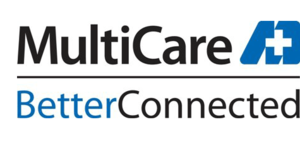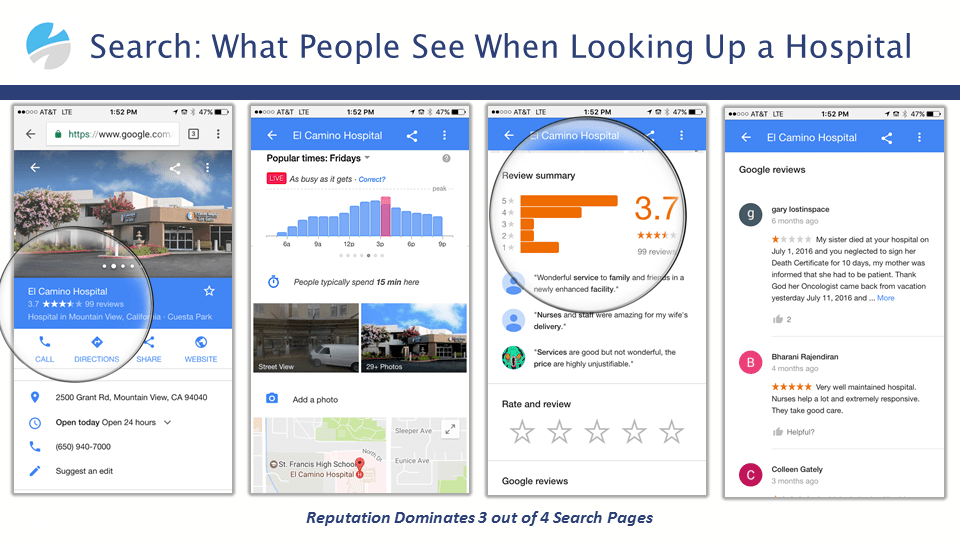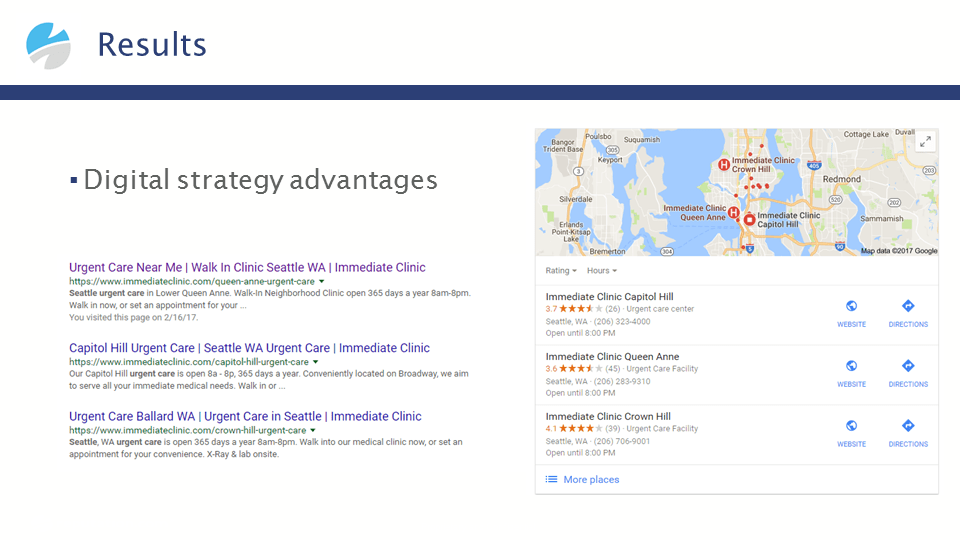Online Reputation Management: How MultiCare Health System’s Systematic Approach Drives Results
// By Becky Barney-Villano //
Reputation management has never been more important for healthcare providers and organizations that are actively seeking new patients. Why? The increase in high-deductible health plans has created a new breed of healthcare shopper. The rise of insurance exchanges where consumers pick their plans has resulted in more robust and careful comparisons among healthcare providers. And the willingness of the average person to write and post reviews is making healthcare more transparent than ever. If you aren’t paying attention, you need to be.

Kirsten Saint Clair, director of business operations at MultiCare Health System
That was the message delivered during the eHealthcare Strategies and Trends webinar “The Four Pillars of Online Reputation Management for Healthcare.” During the webinar, speakers Kirsten Saint Clair, director of business operations at MultiCare Health System in Seattle, and Pascal Bensoussan, chief product officer at Reputation.com, made a compelling case for the necessity of more robust reputation management.
According to Bensoussan, 92 percent of internet users read reviews, and those reviews actually drive purchasing decisions. “Four out of five consumers trust reviews written by people they don’t know as much as they rely on word-of-mouth opinions of family and friends,” he says. “According to the Harvard Business Review, a one-star difference in a star rating can lead to a 5 to 9 percent difference in revenue.”
Three ways consumers discover businesses: search, maps, and social media

Pascal Bensoussan, chief product officer at Reputation.com
When it comes to finding healthcare providers, 77 percent of consumers begin their search online. A startling 84 percent of patients turn to online review sites such as Google, HealthGrades, Vitals, and Yelp to evaluate doctors. And it’s highly likely that they will be using their smartphones or tablets for the search.
“When they search for a provider—doctor or hospital—on Google or Bing, people see ratings, pictures of the building, the location on a map, the distribution of ratings, and actual reviews. In fact, three of the four pages people see when they search on Google are just about reputation,” notes Bensoussan. “If your physicians and facilities have received a large number of reviews, your location dot will actually be larger and more prominent on the map.”
People who launch Google maps to search for a provider will see locations with a number of dots, some big and some small. “The size of the dot is influenced not only by the volume of reviews but how recent they are and the sentiments of the consumer reviews,” he says.
In terms of visibility on social media, Facebook is the number-one application on mobile devices and has the highest volume of daily users in the world. Although it started as a social networking platform, Facebook has been developing more robust mechanisms to help users review and connect with businesses because in the long run, they generate advertising revenues.
The Four Pillars of Online Reputation for Healthcare
Healthcare providers need to pay attention to four key pillars that determine their online reputation:
Review—CAHPS scores are often higher than what a handful of patient reviews would indicate, and four out of five patients are generally satisfied with their experiences. Encouraging more patients to write reviews helps to present a more accurate view of a hospital/provider’s performance. It is important to respond to both positive and negative reviews quickly and professionally. Set up an earnest and structured response process to create a heightened overall sense of service and resolve issues, resulting in higher star ratings.
Surveys—Surveys allow providers to identify issues before patients write about them. Send a text survey to patients sooner rather than later, and include a link to a simple page with a rating and text box for them to write a review. Keep in mind that the response rate is higher in the morning and in the middle of the week, rather than a Monday or Friday. Organizations that have a third-party patient satisfaction survey process in place should consider publishing the aggregated results on their website.
Business listings—Make sure your business information is correct and consistent on every page, for every location and provider, and for every platform, including Google, Bing, HealthGrades, Vitals, and Facebook. Inconsistencies dilute your web presence and confuse potential patients.
Operational Insights—Patient feedback is a gold mine for identifying issues that may be negatively impacting the customer experience. Long wait times in the office, rude front-line staff, a confusing billing process—all of these issues show up in patient reviews if they are a problem in your organization. Be sure to turn the information gleaned from reviews and surveys into action plans that enhance the patient experience.
Making an Impact: Immediate Clinic Case Study
 Since its inception in 2013, Immediate Clinic has enjoyed rapid growth, and with expansion come challenges. With different management at its 14 centers and no common patient satisfaction tool, Immediate Clinic realized it needed to obtain patient feedback in its highly competitive retail healthcare setting. It understood that the patient experience is critical when healthcare consumers have a choice. That meant establishing a way of monitoring and encouraging patient reviews across all 14 locations.
Since its inception in 2013, Immediate Clinic has enjoyed rapid growth, and with expansion come challenges. With different management at its 14 centers and no common patient satisfaction tool, Immediate Clinic realized it needed to obtain patient feedback in its highly competitive retail healthcare setting. It understood that the patient experience is critical when healthcare consumers have a choice. That meant establishing a way of monitoring and encouraging patient reviews across all 14 locations.
In researching ways to measure patient feedback across all centers and improve customer service, Immediate Clinic looked to Reputation.com and its survey functionality. Reputation.com offers easy tracking with a single platform for flagging when reviews have posted, and require a response, and consolidation of reviews. Reports were also site-specific, so clinics that were doing well on patient satisfaction could share best practices with locations that needed help.
“Before engaging Reputation.com, our challenge was that we didn’t have that many reviews and we didn’t have that many positive ones,” states St. Clair. Immediate Clinic was seeing only 12 reviews a month. “For us, 25 – 30 percent of our patients were coming in from online efforts, so we knew we had to focus on reviews to stay competitive.” Realizing that reviews were important to its online visibility as well as the patient experience, management started a program of sending text message surveys after every patient visit. Immediate Clinic has now nearly doubled its volume of reviews per month, and those are integrated into its search engine optimization efforts.
“The hardest part about starting any new program is getting everyone’s buy-in,” St. Clair states. “So I subscribed our whole management team to receive our daily summary of reviews.” Now, staff responses to reviews are occurring 85 percent of the time, up significantly from a low of 7 percent. Immediate Clinic now owns the top-three location dots on Google Maps due to its volume of reviews. Management is operationalizing the importance of customer satisfaction by sending daily summaries of reviews, and educating staff about the importance of asking patients to write a review.
What stands between your marketing spend and new-patient revenue
Clearly, Online Reputation Management is important to the long-term success of any healthcare enterprise. The moment that a potential patient finds a provider or facility on the web—and sees star ratings and reviews—is the decision-point that stands between marketing expenditures and the revenue associated with that patient. “By focusing on reviews, surveys, and business listings, and using the operational insights that result, providers can enhance the patient experience and win the hearts, minds, and visits of healthcare consumers,” notes Bensoussan.
Becky Barney-Villano has served as the top marketing executive at several hospitals, and has been writing on healthcare-related topics for more than 30 years.




